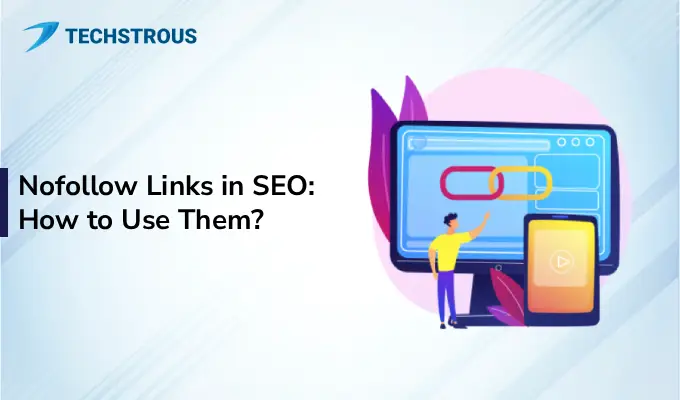Overview
You may have heard the term “Nofollow link” but wonder what they are. In this blog post, we will explain nofollow backlink, their importance, use, and comparison with dofollow backlinks. So, read the article till the end to get complete information.
What are Nofollow Links in SEO?
A nofollow link is a hyperlink with the rel=”nofollow” attribute. It works like any other link except that it instructs search engines not to follow that link. Therefore, in SEO, where link building is an effective strategy for gaining authority, nofollow-type links have a minimal impact.
How to Identify If the Link is Nofollow?
You can easily check whether a particular link is nofollow or not. Right-click on the link and select “Inspect” from the context menu. It will open the HTML tag used for the link. If the rel=”nofollow” attribute is used, the link type is nofollow.
Nofollow vs. Dofollow Links
Both Nofollow and Dofollow backlinks work in the same way. As a user, you cannot tell the difference. Dofollow link allows passing the link authority, which further improves the page ranking. On the other hand, a nofollow backlink does not pass the link authority. They instruct search engine bots not to follow this link.
Another difference between do follow and no follow is in the tag. Whenever you add a hyperlink, it is generally dofollow by default. Whereas, nofollow links are characterized by the rel=”nofollow” attribute in the link tag.
Why Do We Use Nofollow Links?
Now, you might be thinking what the point of using a no follow link is if it does not contribute to improving ranking. There are many scenarios when only links with nofollow attributes serve the purpose. Below, we are sharing some reasons for using the nofollow links.
#1. Referral Visitors: While nofollow backlinks do not pass link authority, visitors can still click on the link and land on your website’s page. When you build a link on another website, it is for two reasons. First, it helps to increase your website’s authority (by passing the link authority).
Second, it allows visitors to click on the link and visit your web page. Although a no follow link does not fulfill the first purpose, it helps in getting more traffic.
Also Read: Understanding the Robots.txt File: A Complete Guide
#2. Brand Promotion: An article/blog that contains links posted on a high authority website is an impactful brand promotion technique. Many users who regularly visit that website will also learn about your website. Regardless, the link is nofollow, users will know your brand.
#3. Natural Link Diversity: No-follow links make your link profile natural. If you have only dofollow links, it will make your website seem unnatural, and you are more likely to face a Google penalty. Take any big website. They contain dofollow links as well as plenty of no follow links.
Do Nofollow Links help in SEO?
Nofollow links are not as impactful as dofollow links, but they still contribute to improving SEO. Google says that it does not follow nofollow backlinks. However, in many cases, it has been shown that no follow links also helps in SEO.
The key point to consider here is that the link should be from a high-authority website that is related to your website’s niche. Moreover, you must use the nofollow attribute for any paid links, like affiliate links, ads, sponsored posts, etc., to prevent penalties.
How to Use Nofollow Links in SEO?
The main rule for using a nofollow link is when you are referring to something but don’t want to endorse it, such as sponsored links, ads, etc.
Any link on your website that is created by a user should be nofollow. It helps avoid any spammy links. However, WordPress automatically adds a nofollow tag for links in comments. So, if you use WordPress, you do not need to do it manually.
When to Avoid Nofollow Link-
We have discussed when to use nofollow links, but sometimes people use these links in the wrong way. There are two main scenarios when you should avoid using the no follow backlink.
#1. For external links: It is considered that if you use nofollow for every external link (links directing to a different site), it will prevent transmitting the link equity, which is better for SEO. However, it is not that true. You should not use the nofollow attribute for references, citations, or more information (unless it is sponsored or affiliated).
#2. For Internal Links: Internal links are an important part of your SEO strategy. Whenever you link a page that contains the relevant information, you should always use dofollow links. It helps in SEO as well as provides users with the desired information they want.
A page to which no internal links are directed is called an orphan page, and having such a page is not good for a website’s SEO.
NoFollow vs. NoIndex
People are often confused between nofollow and noindex. A noindex is a meta tag that you use when you don’t want to index that page. It tells the search engine bots not to index a particular page, which ultimately prevents it from appearing in search results.
On the other hand, the nofollow attribute does not give such instructions to the bots. It simply suggests not to follow that link. However, the page will still appear in the search results. Therefore, you should use the noindex directive for every page that you don’t want to get indexed.
Conclusion
Nofollow links are characterized by the rel=”nofollow” attribute. They instruct search engine bots not to follow that particular link. Although these types of links are not as significant as dofollow links, they still play a major role in a website’s ranking. The key point to understand here is that you should only use the nofollow attribute for those links that you want to refer to but don’t endorse.




